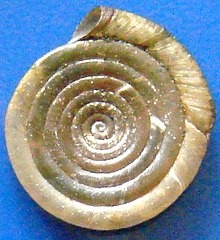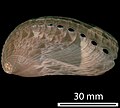


A whorl is a single, complete 360° revolution or turn in the spiral or whorled growth of a mollusc shell. A spiral configuration of the shell is found in numerous gastropods, but it is also found in shelled cephalopods including Nautilus, Spirula and the large extinct subclass of cephalopods known as the ammonites.
A spiral shell can be visualized as consisting of a long conical tube, the growth of which is coiled into an overall helical or planispiral shape, for reasons of both strength and compactness.
The number of whorls which exist in an adult shell of a particular species depends on mathematical factors in the geometric growth, as described in D'Arcy Wentworth Thompson's classic 1917 book On Growth and Form, and by David Raup. The main factor is how rapidly the conical tube expands (or flares-out) over time. When the rate of expansion is low, such that each subsequent whorl is not that much wider than the previous one, then the adult shell has numerous whorls. When the mathematical factors governing the pattern of growth are such that there is a very rapid expansion of the conical shape, of the shell tube, then the adult shell has very few whorls.
The number of whorls present in an adult shell differs greatly in various taxa. The extant marine gastropod families Turritellidae and Terebridae, and the extinct Mesozoic family Nerineidae, have very high spired shells with a large number of whorls, and a relatively small aperture.
The shells of a few genera of gastropods, and of the cephalopod genus Spirula, have whorls that are disconnected.
-
The shell of the marine gastropod Haliotis asinina has fewer than two whorls
-
The shell of Spirula spirula has disconnected whorls

